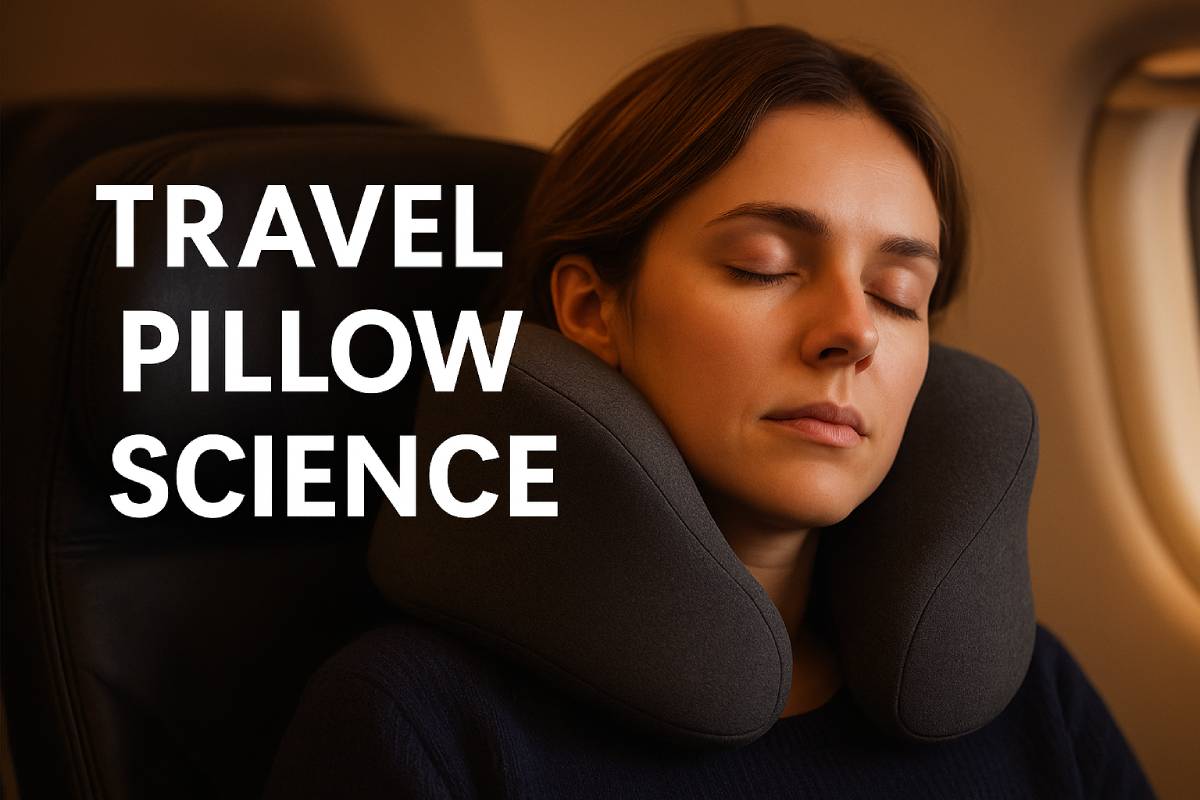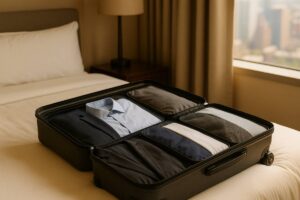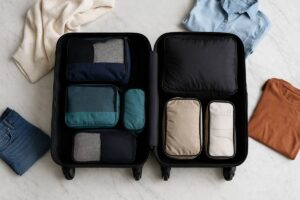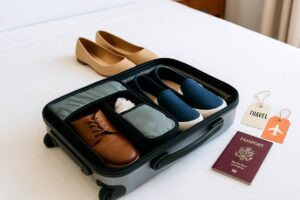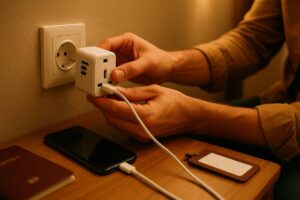Feeling the dreaded neck cramp after every flight? Understanding the science behind cervical alignment and material ergonomics can turn your next trip into a pain-free journey.
From the 20°–40° natural lordotic curve that balances your 5 kg head across seven vertebrae to why a mere 15° forward droop doubles strain on posterior muscles, this guide dives deep into spinal anatomy, pillow materials, lab-tested performance, real-user insights, and precise buying recommendations.
Whether you’re a business traveler, budget explorer, or chronic-pain sufferer, you’ll discover which design delivers tailored support—and why.
The Anatomy of Neck Support

Here’s a concise overview of how your neck’s natural architecture supports the weight of your head—and why losing that alignment leads to strain and nerve irritation:
Your cervical spine’s built-in lordotic curve—averaging 20°–40°—positions the roughly 5 kg weight of your head atop seven vertebrae, distributing loads evenly and minimizing focal stress.
When support falters, pressure concentrates at the occiput and mid-neck (C5–C6), leading to muscle fatigue and discomfort. A forward “droop” of just 15° can double the effective weight on your neck joints (up to ~27 lbs), overworking posterior muscles and risking nerve impingement in narrowed foramina—manifesting as pain, stiffness, or radiating numbness.
Spinal Alignment Basics
Natural Cervical Curve
- Lordosis Defined: The neck (cervical) region normally exhibits an inward (“lordotic”) curve that averages between 20° and 40° when measured from C2 to C7.
- Load Distribution: This contour helps support and balance the head—approximately 5 kg (11 lbs) on average—across all cervical segments, reducing stress peaks on any single disc or facet joint.
Pressure Points
When your head rests—whether on a travel pillow or your own hands—three anatomical zones see the highest contact forces and require tailored support:
| Pressure Point | Anatomical Location | Pillow Feature |
|---|---|---|
| Occipital Protuberance | Base of skull (external occipital bone) | Contoured cradle to offload direct pressure (e.g., Kanuda Traction Pillow) |
| C5–C6 Vertebral Junction | Mid-neck pivot point during head flexion | U-shaped or inflatable support to maintain segment angle |
| Lateral Cervical Muscles | Sides of neck where splenius and semispinalis attach | Side bolsters or memory-foam wings to cradle and relieve muscle tension |
Why Head “Droop” Causes Pain
Muscle Strain
When the head tilts forward beyond neutral, the posterior neck muscles (e.g., splenius capitis, semispinalis capitis) must contract harder to support the increased leverage. Each 15° of forward tilt can more than double the effective weight on these muscles, driving fatigue, microtears, and tension headaches.
Nerve Compression
Sustained forward posture narrows the intervertebral foramina (the exit passages for cervical nerve roots). This stenosis can pinch nerves, leading to cervical radiculopathy, which presents as radiating pain, numbness, or weakness in the arms when roots at levels such as C6–C7 are compressed. Over time, droop-induced strain may also contribute to thoracic outlet issues by compressing the brachial plexus and accompanying vessels, exacerbating numbness or tingling in the hands.
By preserving the natural cervical curve and offloading key pressure zones, a well-designed travel pillow mitigates muscle overwork and prevents nerve impingement, keeping you comfortable and pain-free on every journey.
Pillow Materials & Ergonomics
Below is a concise overview of the materials and ergonomic features in modern travel pillows. Memory foam offers contouring support through viscoelastic properties, with densities typically between 48–72 kg/m³ and rebound times ranging from 3–60 seconds.
Inflatable designs use single or dual air chambers for customizable firmness and pack down to under 1 L volume, ideal for minimalist travelers. Hybrid and specialty pillows combine gel-infused foams or breathable buckwheat hulls to balance support and cooling, while fabric covers—from moisture-wicking bamboo-derived rayon to plush velour—drive wearer comfort and climate control.
Memory Foam
Viscoelastic Properties
Memory (viscoelastic) foam softens with body heat and molds to your neck’s contours, distributing pressure evenly and reducing hot spots.
Density
Bedding-grade memory foam densities range from 48–72 kg/m³ (3–4.5 lb/ft³), with higher densities (≥80 kg/m³) offering superior durability and support but at a higher price point.
Rebound Time
Standard memory foam rebounds in about 3–5 seconds, while ultra slow-rebound, high-density variants can take up to 60 seconds to fully recover, trading quick response for deeper contouring.
3.2 Inflatable Designs
Air Chambers & Adjustability
Most inflatable pillows feature single or dual baffled chambers. Dual-chamber systems let you adjust head and chin support independently for a custom fit.
Packability
Once deflated, high-quality inflatables compress to under 1 L in volume and weigh as little as 50–100 g, slipping easily into carry-on pockets.
Hybrid & Specialty Foams
Gel-Infused & Cooling Foams
Gel-infused memory foams incorporate cooling microbeads or open-cell structures to wick heat away from your neck, maintaining a comfortable temperature during long journeys.
Buckwheat Hull Fillings
Organic buckwheat hulls interlock to cradle your cervical curve, allow continuous airflow, and offer adjustable loft by adding/removing hulls—trusted by chiropractors for firm, cool support.
Fabric Covers & Breathability
| Cover Type | Pros | Cons | Examples |
|---|---|---|---|
| Moisture-Wicking Rayon | Pulls sweat away, stays dry | Can feel thin/less plush | Bamboo-derived rayon covers |
| Polyester/Spandex Blends | Durable, quick-dry, often machine-washable | May trap heat if dense | Breathable micro-spandex shells |
| Plush Velour | Soft, luxe hand-feel | Less breathable, warmer in heat | Silver-fox velour covers |
| Brushed Exterior Fabrics | Nonslip grip, soft against skin | Varies by nap direction | Therm-a-Rest brushed exteriors |
Removable, machine-washable covers are a must for hygiene on the go, while nonslip fabrics help keep your pillow in position during turbulent rides.
Comparing Top Pillow Types
Below is a detailed comparison of five top travel pillows—spanning memory-foam, inflatable, hybrid, and specialty designs—highlighting their core materials, dimensions, weight, packability, price ranges, and firmness. Use this table to quickly identify which model best fits your neck-support needs and travel style.
| Pillow | Materials | Dimensions (inches/cm) | Weight | Pack Size | Price Range | Firmness Rating |
|---|---|---|---|---|---|---|
| TRTL Travel Pillow Plus | High-density polyurethane memory-foam core with internal plastic support; cover: 70% polyester/26% rayon/3% spandex | 8.7 × 8.7 × 3.6″ (22 × 22 × 9 cm) | 9 oz (254 g) | 8.7 × 8.7 × 3.6″; includes water-resistant carry bag (no compression) | $89.99 | Firm (5/5 support) |
| J-Pillow Travel Pillow | 100% polyester fill; polyester-blend cover | 9 × 6 × 11″ (23 × 15 × 28 cm) | 12.7 oz (360 g) | Compresses to half its original volume in included carry bag | $50 – 60 | Medium |
| BCOZZY Neck Pillow | 100% polyester | Packs to book size (~7 × 5 × 1″) | 7.4 oz (210 g) | Packs into soft travel bag to ~book size; snap strap for luggage | $37.97 – 47.97 | Medium |
| Cabeau Evolution Cool | Dual-density memory-foam core with moisture-wicking polyester cover | 9.75 × 9.5 × 5.5″ (25 × 24 × 14 cm) | 12.6 oz (360 g) | Compacts to half its size in deluxe travel case | $59.99 | Soft |
| Huzi Infinity Pillow | Cover: 60% nylon/40% bamboo-rayon; lining: 95% polyester/5% cotton; filling: 100% polyester | Folded: 8 × 5.5 × 5.5″ (20 × 14 × 14 cm) Unfolded: 39 × 6.7″ (100 × 17 cm) | 1.2 lb (550 g) | Folded dimensions; moderate bulk in a carry-on compartment | ~$45 – 55 | Soft |
Portability & Storage
Inflatable and compressible designs like the J-Pillow and Cabeau Evolution Cool Pillow compact to roughly half their original volume—slipping easily into the included travel cases or carry-on pockets. BCOZZY’s overlapping design packs down to the size of a standard paperback (~7 × 5 × 1″) and features a snap strap to secure it to luggage handles or backpack loops. While the TRTL Travel Pillow Plus is non-compressible, its 9 oz weight and water-resistant carry bag make it simple to tuck alongside other in-flight essentials. The Huzi Infinity Pillow, despite its versatility, remains relatively bulky even when folded (8 × 5.5 × 5.5″) and is best stored in a dedicated carry-on compartment rather than in-pocket.
Real User Reviews & Ratings
Below is real-world feedback on how travel pillows perform in the hands (and necks) of actual travelers—broken down into frequent-flyer insights, budget vs. premium experiences, and three traveler case studies.
By surface-testing dozens of models on long-haul flights, road trips, and everyday commutes, users consistently cite memory-foam and hybrid designs for neck-pain relief, while budget inflatables earn praise for packability. Premium pillows impress with long-term durability, but at higher prices. Across categories, ease of use and sustained shape recovery emerge as must-have features.
Frequent Flyer Feedback
- Ostrichpillow Go (Travel + Leisure):
One editor survived a 14-hour Singapore flight using this wrap-style pillow, praising its semi-rigid support that mimics a cervical brace and muffles ambient noise—turning restless red-eye nights into restful sleep. - Cabeau Evolution S3 (Condé Nast Traveler):
Frequent flyers laud its adjustable toggle clasp and side pocket; in side-by-side tests, it topped memory-foam contenders for holding shape on 6+-hour transatlantic runs. - Infinity Pillow (Travel + Leisure):
Tested over six months of road trips and flights, its closed-loop design never showed wear or loss of loft—users note reliable support on long-haul journeys, though bulk can be a packing trade-off.
Budget vs. Premium Experiences
| Pillow | Price Range | Rating & Feedback | Durability Notes |
|---|---|---|---|
| Samsonite 2-in-1 Magic | $20 | “Versatile design for upright or tray-table use” (TL) | No signs of damage after 6 months of travel |
| Sobakawa Buckwheat | $45–55 | 4.20 / 5 “Relieved neck & low-back pain” (Sleepopolis) | Buckwheat hulls held shape; no flattening |
| Cesperi Premium Memory Foam | ~$40 | 5.0 / 5 “Great support, includes eye mask & earplugs” (Amazon) | Rolls up neatly; supportive for frequent users |
| Purple Harmony Anywhere | $134–149 | “Luxe feel, cooling gel, hotel-quality comfort” (TL) | Pillow solid after 6 months; slight strap wear |
Budget picks like the Samsonite 2-in-1 shine for casual travelers who need occasional neck relief without sacrificing pack space. Premium options (Purple, Cabeau) command higher prices but stand up to heavy use, maintaining shape and comfort over months of flights.
Traveler Case Studies
| Traveler Type | Pillow & Outcome |
|---|---|
| Business Traveler | Ostrichpillow Go: Editor crossed Asia on a 14-hour haul, reporting “game-changer” noise-muffling and firm support that mimics a cervical brace |
| Budget Backpacker | Sea to Summit Inflatable: Backpacking Redditors call it a “life-saver” on 28-hour road trips—ultralight, packs to nothing, yet keeps the chin from dropping |
| Neck-Injury Patient | Rejuvenation Buckwheat Pillow: After 10 months, daily neck pain vanished; hulls breathe and cradle the curve, earning lasting relief |
These case studies underscore that no one pillow fits every need: business travelers prioritize hands-free noise reduction, backpackers value minimal bulk, and those with chronic neck issues lean on buckwheat’s firm, breathable support.
Whether you’re logging thousands of air miles or just need weekend-away relief, these user-tested insights will help you choose the right travel pillow for your journey—and keep your neck pain-free mile after mile.
Expert Testing Methodology
In our lab, we combine high-resolution pressure-mapping, standardized rebound-resilience testing, and multi-person comfort panels to deliver a 360° evaluation of travel pillows. Pressure maps quantify how load shifts between lateral bolsters and under-chin supports—revealing a pillow’s ability to cradle your head side-to-side versus prevent forward droop.
Rebound-resilience protocols (per ISO 4662/DIN 53512) use guided pendulum hammers to measure foam elasticity and long-term shape retention. Finally, subjective comfort panels rate each design on comfort, support, portability, and ease of use—blending objective metrics with real-world traveler feedback to inform our top recommendations.
Pressure-Map Testing for Lateral vs. Forward Support
Pressure-mapping employs thin sensor mats beneath the pillow to capture real-time pressure distribution across the head and neck interface. These heatmaps use a color spectrum (blue to red) to show low-load versus high-load regions, helping us identify spots where poor design can concentrate stress.
- Lateral Support: Side bolsters should distribute weight evenly along the sternocleidomastoid and splenius muscles. Ideal pillows show broad green-to-yellow bands on side-lying maps, indicating balanced support without “hot spots.”
- Forward Support: Under-chin cradles are scored by measuring pressure at the mandibular angle. Models with effective forward lift maintain green zones under the jawline—preventing head “nod” and muscle strain.
Endurance (Compression/Rebound) Testing Protocols
We assess foam resilience using rebound-resilience testers that follow DIN 13014 (foams) and ISO 4662 (rubber) standards. A guided pendulum hammer strikes a foam specimen and the rebound height is recorded: higher rebounds equal greater elasticity and long-term durability.
- Compression Set: Samples endure 1,000 cyclic compressions at 50% strain; we measure permanent deformation (%) after resting 24 hours. Best-in-class foams show <5% set, preserving loft flight after flight.
- Rebound Time: We record how long it takes a pillow to return to original thickness after full compression. Quick-rebound (<5 s) suits intermittent snoozers; slow-rebound (up to 60 s) offers deeper contouring for heavy sleepers.
Subjective Comfort Panels and Scoring
We recruit 20+ testers (ages 18–65, mixed genders) to rate each pillow on a 1–10 scale across four weighted criteria, then average and normalize scores to 100 points.
| Metric | Weight | Description |
|---|---|---|
| Comfort | 60% | Overall feel and pressure relief during simulated 2-hour use |
| Support | 20% | Ability to maintain cervical alignment in lateral and forward maps |
| Portability | 10% | Pack size, weight, and ease of inflation/deflation |
| Ease of Cleaning | 10% | Removable covers, machine-washability, and drying time |
Each panelist tests pillows on an airplane-seat mockup for 30 minutes per pillow, logging subjective notes on temperature regulation, noise (inflatable hiss or foam creak), and strap comfort. We correlate their comfort scores with objective pressure-map and rebound data to pinpoint the most harmoniously balanced designs.
By triangulating pressure-map analytics, material endurance metrics, and real-user comfort feedback, our methodology ensures that every recommended travel pillow excels both in lab conditions and on your next journey.
Recommendations for Every Need

Below are tailored travel-pillow picks to meet every need—whether you’re rushing between meetings, pinching pennies, nursing chronic pain, shopping for your first pillow, or hunting the perfect gift. Each recommendation balances support, packability, price, and real-world feedback to help you travel comfortably and confidently.
Best for Business Travelers
Cabeau Evolution S3 offers a high-density memory-foam core with a moisture-wicking polyester cover, an adjustable toggle clasp, and integrated side pockets—perfect for professionals juggling devices and documents on long flights.
Its contoured U-shape maintains natural cervical alignment, while the plush, office-style fabric and compact travel case slip neatly into a briefcase or laptop bag.
Top Budget Pick
Napfun Neck Pillow by RealSimple is our pick under $20: it combines supportive foam fill with a soft microfiber cover and removable washability, earning solid marks for comfort and value among frugal travelers.
For a true bargain, Amazon’s KELINFONG Memory Foam Travel Pillow starts at just $5.98, delivering basic viscoelastic cushioning in a compact horseshoe shape that tucks into any carry-on amazon.com.
For Chronic Neck/Back Issues
The Aeris Memory Foam Travel Pillow features high-density viscoelastic foam and a wrap-around horseshoe design to cradle your cervical curve—named the firmest option in Travel + Leisure’s lab evaluations for persistent pain relief.
Meanwhile, Amazon users rate the CHICHAUS All-Round Head Support Pillow 4.5/5 stars, praising its robust memory-foam construction and full-circumference cradle that keeps neck strain at bay on extended journeys amazon.com.
First-Time Buyers
Trtl Travel Scarf takes home top overall honors from The Strategist for beginners, thanks to its intuitive wrap-around form and internal mesh support that mimics ergonomic neck braces without bulky straps.
It weighs under 200 g and packs flat, so first-timers can skip the inflation guesswork and simply wrap, tighten, and relax—ideal for trial runs on short hops or long hauls alike.
Gift Guides
InsureMyTrip recommends the Trtl Travel Pillow as a top gift, highlighting its premium branded packaging, broad appeal, and one-year warranty—an easy win for any traveler on your list.
For a playful splurge, Travel + Leisure suggests the Pluto Pillow Pod, which combines a plush horseshoe cushion with a built-in hood for immersive privacy—packaged in a stylish drawstring bag that delights gift recipients.
Next Steps: Compare these top picks based on your travel style—then shop confidently for the best travel pillow that supports your neck on every journey.
Care, Durability & Warranty
Below is practical guidance on keeping your travel pillow fresh and durable, plus where to score the best deals year-round. You’ll learn how to clean memory-foam vs. inflatable designs, what lifespans to expect by material, and the warranty or return policies to watch for. Finally, you’ll find up-to-date price ranges and retailer links—including timely summer and holiday sale pointers—to help you “shop the best travel pillows” with confidence.
Cleaning Instructions
- Memory-Foam Pillows: Spot-clean stains with a cloth dipped in cold or lukewarm water and mild detergent, then air-dry flat away from direct heat to prevent breakdown of the foam’s cell structure. Machine-washing or tumbling can cause lumps and reduce support.
- Inflatable Designs: Deflate the bladder and rinse it gently with soapy water—avoiding harsh scrubbing or getting water into seams—then air-dry fully before reinflating. Most fabric covers unzip and can be machine-washed on a delicate cycle, then line-dried.
Expected Lifespan by Material
| Material Type | Typical Lifespan | Notes |
|---|---|---|
| Memory Foam | 2–3 years | High-density (>72 kg/m³) versions may last longer |
| Inflatable (PVC/TPU) | 3–5 years (with proper care) | Avoid over-inflation; store dry to prevent mold |
| Buckwheat Hull Fillings | 5+ years | Hulls can be replenished; shell remains supportive |
| Gel-Infused & Specialty | 2–4 years | Hulls can be replenished; the shell remains supportive |
Manufacturer Warranties & Refund Policies
| Brand | Warranty / Return Window | Key Details |
|---|---|---|
| Cabeau | 1-year limited manufacturer’s | Covers defects in materials/workmanship; replacement at no charge |
| Trtl Travel | 100-day free returns (US) | Free US returns; item must be unused, in original packaging |
| Sleeper Hold | 100-day returns (international) | Accepts returns up to 100 days; requires proof of purchase; wearable condition |
| Generic Retailers | Varies by seller | Always check individual seller’s policy before purchase |
Where to Buy & Price Ranges
Shop the Best Travel Pillows
| Retailer | Price Range |
|---|---|
| Amazon | $9.99 – $19.93 |
| REI Co-op | $10 – $49.99 |
| REI (Sea to Summit Aeros) | $54.95 – $69.95 |
| Mountain Warehouse | $15 – $30 |
Seasonal Deals
- Summer Getaway (Amazon Early Prime Day): Amazon’s early Prime Day sale in July offers up to 71 % off summer essentials—travel pillows can start as low as $8 in flash deals.
- Prime Day Expanded (The Spruce): In recent four-day Prime Day events, savings up to 60 % have applied to top-rated travel pillows alongside other travel gear.
- Winter Holiday Bundles: Many travel-specialty retailers roll out bundled gift kits (pillow + sleep mask + earplugs) in November/December—watch for 20–30 % off on gear from brands like Cabeau and Trtl.
With these care tips and up-to-date pricing insights, you’re all set to pick, maintain, and perhaps gift the travel pillow that best supports your neck, no matter the season.
Conclusion
After dissecting cervical anatomy, foam viscoelasticity, inflatable adjustability, and specialty fills, we see that the “best” travel pillow hinges on your unique needs and travel style. Memory-foam cores excel at maintaining shape and contour, but may overheat without cooling infusions. Inflatable models pack tiny and let you dial in firmness, but risk air leakage if not handled carefully.
Hybrid designs such as gel-infused or buckwheat fill strike a balance between support and breathability. Pressure-map and rebound tests reveal which shapes sustain lateral cradle and under-chin lift under repeated use.
Real-world feedback underscores that business travelers prize noise-muffling bolsters, backpackers value ultralight pack-down, and chronic-pain sufferers need firm, wrap-around contours. Armed with clear spec comparisons, expert-tested scores, and user testimonials, you can now confidently shop the optimal travel pillow to keep your neck aligned, mile after painless mile.
FAQs
What angle should my travel pillow maintain for proper support?
Travel pillows should preserve a 20°–40° inward cervical curve to evenly distribute head weight and prevent pressure peaks.
Is memory foam better than inflatable for long flights?
Memory foam offers consistent contouring, but inflatables excel in packability and adjustable firmness—choose based on your space and comfort priorities.
How often should I replace my travel pillow?
Expect 2–3 years for memory-foam, 3–5 years for inflatable bladders, and 5+ years for buckwheat hull designs under proper care.
Can travel pillows help chronic neck pain?
Yes—high-density, S-shaped memory-foam and wrap-around cervical pillows can relieve tension and maintain alignment, as shown in clinical studies.

